可数名词单数变复数规律
可数名词单数变复数的变化规则

可数名词单数变复数的变化规则可数名词是指可以用数目来计量的名词,而单数和复数则是名词的不同形式。
在中文中,我们常常通过在名词后面加上“们”、“等”、“们”等后缀来表示复数形式,但在英语中,单数名词变为复数名词的规则更为多样化。
下面,我将为你详细解释可数名词单数变复数的变化规则。
一、一般规则1. 名词后加-s大多数可数名词在单数后加-s构成复数形式,如book(书)变为books(书籍)、cat(猫)变为cats(猫咪)等。
2. 名词后加-es如果名词以s, x, ch, sh结尾,复数形式变为加-es,如box(盒子)变为boxes(盒子)、watch(手表)变为watches(手表)等。
3. 名词后加-ies如果名词以辅音字母+y结尾,复数形式变为去y变i再加-es,如baby(宝宝)变为babies(宝宝们)。
二、特殊规则1. 名词本身变化一些名词在单复数形式上的变化是完全不同的,如man(男人)变为men(男人们)、woman(女人)变为women(女人们)等。
2. 不规则变化一些名词的复数形式并不遵循一般规则,而是需要记忆,如child (孩子)变为children(孩子们)、foot(脚)变为feet(脚)等。
三、无变化一些名词的单复数形式完全相同,如sheep(羊)、deer(鹿)等。
以上便是可数名词单数变复数的一般规则和特殊规则,通过这些规则我们可以更加准确地使用名词的复数形式,让我们的表达更加准确。
可数名词单数变复数的规则有一般规则和特殊规则两部分,其中一般规则是比较容易掌握的,而特殊规则则需要通过记忆来掌握。
不过,通过不断的练习和积累,我们相信大家一定可以熟练掌握这些规则,从而在用英语表达时更加得心应手。
在平时的学习中,我们可以通过阅读、写作和口语练习来巩固这些规则,让它们成为我们语言运用的一部分。
在掌握了名词单数变复数的规则后,我们也可以更加流利地进行交流,给我们的表达增添更多的灵活性。
名词单数变复数变化规则

名词单数变复数变化规则:一.可数名词1.一般名词复数是在名词后面加上“s”,如map→maps, bag→bags,book-books 等;2.以s,x, sh, ch结尾的词加“es”,如bus→buses, watch→watches, box-boxes等;3.以f或fe结尾的名词变复数时,去掉f, fe 加ves的名词有: half→halves knife→knives leaf→leaves wolf→wolves wife→wives life→lives thief→thieves4.以o 结尾的名词变复数时:a)加s的名词有(无生命):photo→photos ,piano→pianos, radio→radios b)加es的名词有(有生命): potato→potatoes tomato→tomatoes5.以辅音字母+y结尾的词,变y为i加es,如baby→babies, family-families, study-studies等;以元音字母+ y结尾的名词变复数时,直接加s变复数,如monkey→monkeys,holiday→holidays, storey→storeys(楼层);6. oo变ee的单词:foot-feet, goose-geese, tooth-teeth;7. a变e的单词: man-men, woman-women, policeman-policemen;8. 复数与原形一致的单词:fish-fish, sheep-sheep, deer-deer, Chinese-Chinese, Japanese-Japanese;注:1.fish指“鱼肉”时,是不可数名词;2.fish指“鱼的多少”时,是可数名词,但单数和复数同行;There are many fish in the river。
3.fish强调鱼的“种类“时,复数是“fishes”。
可数名词单数变复数规律

可数名词单数变复数规律:1、词尾直接加s型:students, apples, bags, trees, books, brothers2、以s、x、sh、ch结尾的名词加es型:glasses, boxes, brushes, matches3、以辅音字母加y结尾的名词,变y为i加es型:city-cities, baby-babies4、以元音字母加y结尾的名词,直接加s: boys, toys5、以f或fe结尾的名词,多数变f为v加es: wives, knives, thief, life, half, leaf, shelf, wolf, 除了roof6、以o结尾的名词,一般直接加s: radios, zoos, pianos, photos;除了5个特殊的词需要加es: Negroes, heroes, potatoes, tomatoes,mangoes.(黑人英雄爱吃土豆和西红柿:薯条蘸番茄酱;最后再吃点芒果)7、不规则变化的词:foot→ feet, goose→ geese, tooth→ teeth,man→ men, woman→ women, sh ee p→ sheep, deer→deerChinese→Chinese, Japanese→Japanese,child→ children,mouse→ mice.不规则变化要特别记,oo常常变ee, foot→feet是一例;男人、女人a改e, woman→women是一例;child复数children要记准,中、日、鹿、绵羊无变化,单数、复数是一家。
第三人称单数(他,她,它)是除了你、我,还有复数以外(他们,她们,它们)的人称。
英语中的不可数名词水纸锻炼信息新闻食物水果羊肉牛肉 10. snow雪鸡肉沙拉家务果汁冰冻食品16,tea茶废物粉雨水风头发米饭人口面包牛奶可乐钱果酱蜂蜜巧克力鱼肉肉空间34. advice 建议墨水盐蛋糕找零家庭作业交通和平愤怒勇气能量恐怖有趣乐趣健康时间沙子天气建议你在学习过程中不断积累。
英语可数名词变复数的规则

英语可数名词变复数的规则英语名词单数变复数主要有以下规则:一、绝大多数的可数名词的复数形式,是在该词末尾加上后辍-s。
读音变化:结尾是清辅音读[s],结尾是浊辅音或元音读[z]。
例:friend→friends; cat→cats; style→styles; sport→sports; piece→pieces二、凡是以s、z、x、ch、sh结尾的词,在该词末尾加上后辍-es构成复数。
读音变化:统一加读[iz]。
例:bus→buses; quiz→quizzes; fox→foxes; match→matches; flash→flashes box →boxes; watch→watches;actress→actresses;class→classes;coach(长途车)→coaches;dress→dresses;sandwich →sandwiches; toothbrush →toothbrush es; waitress(女侍者)→waitresses三、以辅音字母+y结尾的名词,将y改变为i,再加-es。
读音变化:加读[z]。
例:candy→candies; daisy(雏菊)→daisies; fairy→fairies; lady→ladies;story→storiesstrawberry→strawberries;baby→babies;puppy→puppies;library→libra ries;dictionary→dictionaries; cherry →cherries; activity →activities四、以-o结尾的名词,如果不是外来词或缩写,就加-es,否则加-s构成复数。
(有生命的加es,无生命的加s)读音变化:加读[z]。
例:tomato→tomatoes;potato→potatoes;torpedo(鱼雷)→torpedoes;bingo (彩票式游戏)→bingoes反例:silo(青贮塔)→silos;piano→pianos(外来词);photo→photos;macro (宏指令,计机算语言)→macros(缩写词)五、以-f或-fe结尾的名词,多为将-f或-fe改变为-ves,但有例外。
英语名词单数变复数的规则
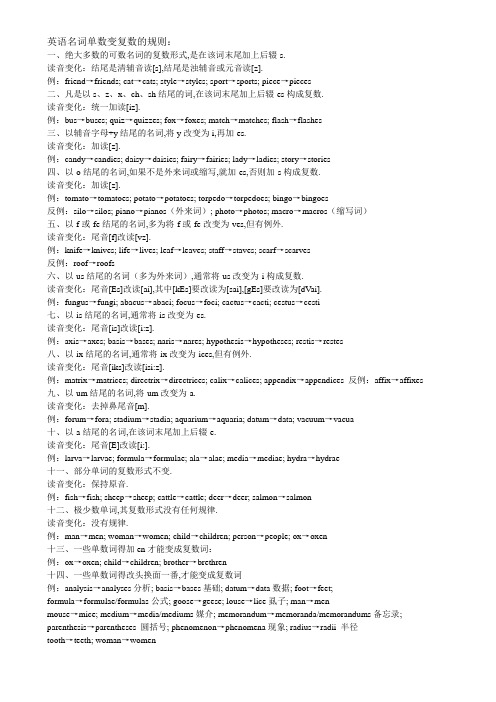
英语名词单数变复数的规则:一、绝大多数的可数名词的复数形式,是在该词末尾加上后辍-s.读音变化:结尾是清辅音读[s],结尾是浊辅音或元音读[z].例:friend→friends; cat→cats; style→styles; sport→sports; piece→pieces二、凡是以s、z、x、ch、sh结尾的词,在该词末尾加上后辍-es构成复数.读音变化:统一加读[iz].例:bus→buses; quiz→quizzes; fox→foxes; match→matches; flash→flashes三、以辅音字母+y结尾的名词,将y改变为i,再加-es.读音变化:加读[z].例:candy→candies; daisy→daisies; fairy→fairies; lady→ladies; story→stories四、以-o结尾的名词,如果不是外来词或缩写,就加-es,否则加-s构成复数.读音变化:加读[z].例:tomato→tomatoes; potato→potatoes; torpedo→torpedoes; bingo→bingoes反例:silo→silos; piano→pianos(外来词); photo→photos; macro→macros(缩写词)五、以-f或-fe结尾的名词,多为将-f或-fe改变为-ves,但有例外.读音变化:尾音[f]改读[vz].例:knife→knives; life→lives; leaf→leaves; staff→staves; scarf→scarves反例:roof→roofs六、以-us结尾的名词(多为外来词),通常将-us改变为-i构成复数.读音变化:尾音[Es]改读[ai],其中[kEs]要改读为[sai],[gEs]要改读为[dVai].例:fungus→fungi; abacus→abaci; focus→foci; cactus→cacti; cestus→cesti七、以-is结尾的名词,通常将-is改变为-es.读音变化:尾音[is]改读[i:z].例:axis→axes; basis→bases; naris→nares; hypothesis→hypotheses; restis→restes八、以-ix结尾的名词,通常将-ix改变为-ices,但有例外.读音变化:尾音[iks]改读[isi:z].例:matrix→matrices; directrix→directrices; calix→calices; appendix→appendices 反例:affix→affixes 九、以-um结尾的名词,将-um改变为-a.读音变化:去掉鼻尾音[m].例:forum→fora; stadium→stadia; aquarium→aquaria; datum→data; vacuum→vacua十、以-a结尾的名词,在该词末尾加上后辍-e.读音变化:尾音[E]改读[i:].例:larva→larvae; formula→formulae; ala→alae; media→mediae; hydra→hydrae十一、部分单词的复数形式不变.读音变化:保持原音.例:fish→fish; sheep→sheep; cattle→cattle; deer→deer; salmon→salmon十二、极少数单词,其复数形式没有任何规律.读音变化:没有规律.例:man→men; woman→women; child→children; person→people; ox→oxen十三、一些单数词得加en才能变成复数词:例:ox→oxen; child→children; brother→brethren十四、一些单数词得改头换面一番,才能变成复数词例:analysis→analyses分析; basis→bases基础; datum→data数据; foot→feet;formula→formulae/formulas公式; goose→geese; louse→lice虱子; man→menmouse→mice; medium→media/mediums媒介; memorandum→memoranda/memorandums备忘录; parenthesis→parentheses 圆括号; phenomenon→phenomena现象; radius→radii 半径tooth→teeth; woman→women十五、有些名词是单数、复数不分的例:deer; fish; cannon; sheep; salmon 鲑鱼; trout 鳟鱼十六、一些名词虽分单数、复数,但出现次数多的总是单数词例:abscence; clothing; film; help; furniture家具; machinery机械; news; scenery风景; sugar; traffic交通十七、另一些名词则以复数词出现的机会较多例:bellows风箱; clothes; police; shorts短裤; scissors剪刀; spectacles眼镜; shears大剪刀trousers长裤; wages工资十八、compound nouns,这类复数词是以主要的名词来表示例:daughter-in-law→daughters-in-law 媳妇; father-in-law→fathers-in-law岳父man-of-war→men-of-war兵舰; maid-servant→maid-servantsstep-son→step-sons晚子; son-in-law→sons-in-law十九、若表达具体数目,要借助数量词例:pair(对,双); suit(套); a pair of glasses; two pairs of trousers二十、另外还有一些名词,其复数形式有时可表示特别意思,例:goods货物,waters水域,fishes(各种)鱼二十一、除人民币元、角、分外,美元、英镑、法郎等都有复数形式.。
名词单数变复数变化规则

名词单数变复数变化规则:一、绝大多数的可数名词的复数形式,是在该词末尾加上后辍-s。
读音变化:结尾是清辅音读[s],结尾是浊辅音或元音读[z]。
例:friend→friends; cat→cats; style→styles; sport→sports; piece→pieces二、凡是以s、z、x、ch、sh结尾的词,在该词末尾加上后辍-es构成复数。
读音变化:统一加读[iz]。
例:bus→buses; quiz→quizzes; fox→foxes; match→matches; flash→flashes三、以辅音字母+y结尾的名词,将y改变为i,再加-es。
读音变化:加读[z]。
例:candy→candies; daisy→daisies; fairy→fairies; lady→ladies; story→stories四、以-o结尾的名词,如果不是外来词或缩写,就加-es,否则加-s构成复数。
读音变化:加读[z]。
例:tomato→tomatoes; potato→potatoes; torpedo→torpedoes; bingo→bingoes反例:silo→silos; piano→pianos(外来词); photo→photos; macro→macros(缩写词)五、以-f或-fe结尾的名词,多为将-f或-fe改变为-ves,但有例外。
读音变化:尾音[f]改读[vz]。
例:knife→knives; life→lives; leaf→leaves; staff→staves; scarf→scarves反例:roof→roofs六、以-us结尾的名词(多为外来词),通常将-us改变为-i构成复数。
读音变化:尾音[Es]改读[ai],其中[kEs]要改读为[sai],[gEs]要改读为[dVai]。
例:fungus→fungi; abacus→abaci; focus→foci; cactus→cacti; cestus→cesti七、以-is结尾的名词,通常将-is改变为-es。
可数名词单数变复数规律

可数名词单数变复数规律:1、词尾直接加s型:students, apples, bags, trees, books, brothers2、以s、x、sh、ch结尾的名词加es型:glasses, boxes, brushes, matches3、以辅音字母加y结尾的名词,变y为i加es型:city-cities, baby-babies4、以元音字母加y结尾的名词,直接加s: boys, toys5、以f或fe结尾的名词,多数变f为v加es: wives, knives, thief, life, half, leaf, shelf, wolf, 除了roof6、以o结尾的名词,一般直接加s: radios, zoos, pianos, photos;除了5个特殊的词需要加es: Negroes, heroes, potatoes, tomatoes,mangoes.(黑人英雄爱吃土豆和西红柿:薯条蘸番茄酱;最后再吃点芒果)7、不规则变化的词:foot→ feet, goose→ geese, tooth→ teeth,man→ men, woman→ women, sh ee p→ sheep, deer→deerChinese→Chinese, Japanese→Japanese,child→ children,mouse→ mice.不规则变化要特别记,oo常常变ee, foot→feet是一例;男人、女人a改e, woman→women是一例;child复数children要记准,中、日、鹿、绵羊无变化,单数、复数是一家。
第三人称单数(他,她,它)是除了你、我,还有复数以外(他们,她们,它们)的人称。
英语中的不可数名词1.water 水2.paper 纸3.exercise 锻炼rmation 信息5.news 新闻6.food食物7.fruit水果8.mutton羊肉9.beef牛肉10. snow雪11.chicken鸡肉12.salad沙拉13.houswork 家务14.juice 果汁15.ice 冰冻食品16,tea茶17.waste废物18.powder 粉19.rain 雨水20.wind 风21.hair 头发22.rice米饭23.population人口24.bread面包k 牛奶26.coke 可乐27.money 钱28.jam 果酱29.honey 蜂蜜30.chocolate 巧克力31.fish鱼肉32.meat 肉33.space 空间34. advice 建议35.ink 墨水36.salt 盐37.cake 蛋糕38.change 找零39.homework 家庭作业40.traffic 交通41.peace 和平42.anger 愤怒43.courage 勇气44.energy 能量45.fear 恐怖46.fun 有趣乐趣47.health 健康48.time 时间49.sand 沙子50.weather天气建议你在学习过程中不断积累。
可数名词单数变复数规则及练习含答案
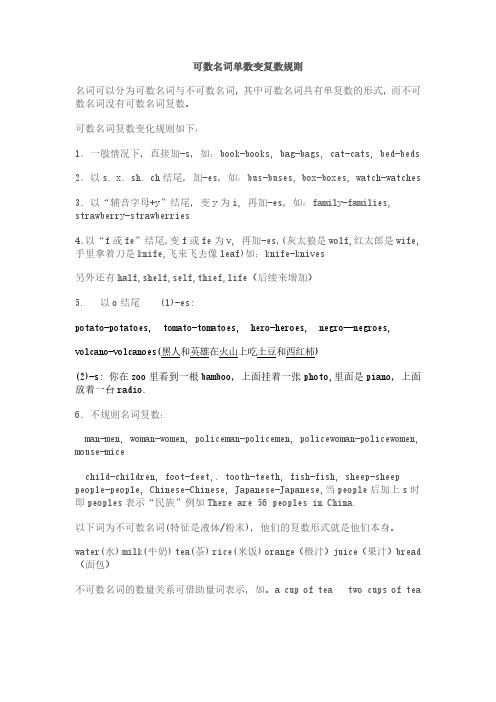
可数名词单数变复数规则名词可以分为可数名词与不可数名词,其中可数名词具有单复数的形式,而不可数名词没有可数名词复数。
可数名词复数变化规则如下:1.一般情况下,直接加-s,如:book-books, bag-bags, cat-cats, bed-beds2.以s. x. sh. ch结尾,加-es,如:bus-buses, box-boxes, watch-watches3.以“辅音字母+y”结尾,变y为i, 再加-es,如:family-families, strawberry-strawberries4.以“f或fe”结尾,变f或fe为v, 再加-es,(灰太狼是wolf,红太郎是wife,手里拿着刀是knife,飞来飞去像leaf)如:knife-knives另外还有half,shelf,self,thief,life(后续来增加)5. 以o结尾 (1)-es:potato-potatoes, tomato-tomatoes, hero-heroes, negro—negroes,volcano-volcanoes(黑人和英雄在火山上吃土豆和西红柿)(2)-s: 你在zoo里看到一根bamboo,上面挂着一张photo,里面是piano,上面放着一台radio.6.不规则名词复数:man-men, woman-women, policeman-policemen, policewoman-policewomen, mouse-micechild-children, foot-feet,. tooth-teeth, fish-fish, sheep-sheep people-people, Chinese-Chinese, Japanese-Japanese,当people后加上s时即peoples表示“民族”例如There are 56 peoples in China.以下词为不可数名词(特征是液体/粉末),他们的复数形式就是他们本身。
可数名词 单数变复数变化规律

可数名词单数变复数变化规律一、绝大多数的可数名词的复数形式,是在该词末尾加上后辍-s。
读音变化:结尾是清辅音读[s],结尾是浊辅音或元音读[z]。
例:friend→friends; cat→cats; style→style s; sport→sports; piece→pieces二、凡是以s、z、x、ch、sh结尾的词,在该词末尾加上后辍-es构成复数。
读音变化:统一加读[iz]。
例:bus→buses; quiz→quizzes; fox→foxes; match→matches; flash→flashes三、以辅音字母+y结尾的名词,将y改变为i,再加-es。
读音变化:加读[z]。
例:candy→candies; daisy→daisies; fairy→fairies; lady→ladies; story→sto ries四、以-o结尾的名词,如果不是外来词或缩写,就加-es,否则加-s构成复数。
读音变化:加读[z]。
例:tomato→tomatoes; potato→potato es; torpedo→torpedoes; bingo→bingo es反例:silo→silos; piano→piano s(外来词); photo→photos; macro→ma cros(缩写词)五、以-f或-fe结尾的名词,多为将-f或-fe改变为-ves,但有例外。
读音变化:尾音[f]改读[vz]。
例:knife→knives; life→lives; leaf→leaves; staff→staves; scarf→scarves反例:roof→roofs六、以-us结尾的名词(多为外来词),通常将-us改变为-i构成复数。
读音变化:尾音[Es]改读[ai],其中[kEs]要改读为[sai],[gEs]要改读为[dVai]。
例:fungus→fungi; abacus→abaci; focus→foci; cactus→cacti; cestus→cesti七、以-is结尾的名词,通常将-is改变为-es。
小学英语可数名词单数变复数规律总结

1.一般情况下,直接加s,如:apple-apple s,pig-pig s,book-book s等2.以s、sh、ch、x结尾的名词,加es,如:bus-bus es(公车),class-class es(班级),fish-fish es(此时的fish当“鱼的种类”讲),watch-watch es(手表),box-box es(盒子), fox-fox es(狐狸)3.以元音字母+y结尾的名词,直接加s,如:boy-boy s(男孩),toy-toy s(玩具)4.以辅音字母+y结尾的名词,去y改ies,如:family-famil ie s(家庭),strawberry-strawberr ies(草莓)5.以f或fe结尾的名词,去f或fe改ves,如:wife-wi ves,knife-kni ves,wolf-wol ves (这三个词的记忆口诀---“妻子”拿着“小刀”杀了“狼”)6.以”o"结尾的名词:(1)有生命的,加es,如:potato-potato es,tomato-tomato es,hero-hero es (这三个词的记忆口诀---”英雄“爱吃”土豆“和”西红柿“)(2)无生命的,加s,如:photo-photo s(照片),radio-radio s(收音机)7.将“oo”改为“ee"的名词,如:tooth-t ee th(牙),foot-f ee t(脚),goose-g ee se(鹅)8.单复同形的名词:(1)fish-fish(此时fish当“同类鱼的很多条”讲),sheep-sheep(绵羊),paper-paper(纸), Chinese-Chinese(中国人),Japanese-Japanese(日本人), people-people(peoples表示“民族”)(2)不可数名词,如:water(水),rice(米饭),milk(牛奶),juice(果汁),bread(面包),tea(茶),orange(橙汁)9.不规则变化的名词:(1)man-men,woman-women (记忆方法---“男人”“女人”将a改e) 延伸:policeman-policemen,policewoman-policemen(2)child-child ren(孩子)(3)mouse-mice(老鼠)(4)根据中文意思变化的名词,如:I-we(我-我们),you-you(你-你们),he/she/it-they(他/她/它-他们),this-these(这个-这些),that-those(那个-那些)同学们,快来看看自己做的怎么样吧!小学英语可数名词单数变复数规律总结写出下列名词的复数形式:I this that watch child photo diary(日记) day(天)foot book dress(连衣裙) tooth sheep box strawberrywolf peach yo-yo(悠悠球) sandwich man womanpaper water juice tea mouseThere are 56 (people)in China.答案:we these those watch es child renphoto s diar ies day s f ee t book s dress est ee th sheep box esstrawberr ies wol ves peach es yo-yo s(悠悠球是“无生命”的,另外含有-符号的词是一个词,因此在结尾加s) sandwich esm e n wom e n paper water juice tea micepeople s(这句话的意思是---“中国有56个民族”)。
可数名词单数变复数的规则
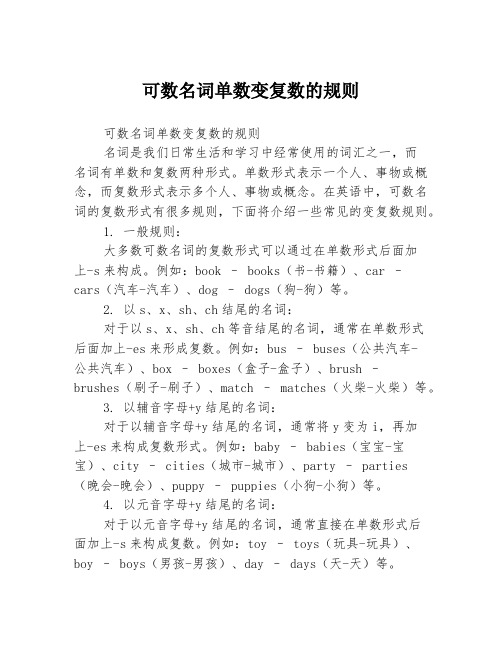
可数名词单数变复数的规则可数名词单数变复数的规则名词是我们日常生活和学习中经常使用的词汇之一,而名词有单数和复数两种形式。
单数形式表示一个人、事物或概念,而复数形式表示多个人、事物或概念。
在英语中,可数名词的复数形式有很多规则,下面将介绍一些常见的变复数规则。
1. 一般规则:大多数可数名词的复数形式可以通过在单数形式后面加上-s来构成。
例如:book – books(书-书籍)、car –cars(汽车-汽车)、dog – dogs(狗-狗)等。
2. 以s、x、sh、ch结尾的名词:对于以s、x、sh、ch等音结尾的名词,通常在单数形式后面加上-es来形成复数。
例如:bus – buses(公共汽车-公共汽车)、box – boxes(盒子-盒子)、brush –brushes(刷子-刷子)、match – matches(火柴-火柴)等。
3. 以辅音字母+y结尾的名词:对于以辅音字母+y结尾的名词,通常将y变为i,再加上-es来构成复数形式。
例如:baby – babies(宝宝-宝宝)、city – cities(城市-城市)、party – parties(晚会-晚会)、puppy – puppies(小狗-小狗)等。
4. 以元音字母+y结尾的名词:对于以元音字母+y结尾的名词,通常直接在单数形式后面加上-s来构成复数。
例如:toy – toys(玩具-玩具)、boy – boys(男孩-男孩)、day – days(天-天)等。
5. 以-f或-fe结尾的名词:对于以-f或-fe结尾的名词,通常将-f或-fe变为-v,再加上-es来构成复数形式。
例如:leaf – leaves(叶子-叶子)、knife – knives(刀-刀)、life – lives(生命-生命)等。
6. 特殊规则:有一些名词的复数形式是不规则的,需要记住具体的形式。
例如:man – men(男人-男人)、woman – women(女人-女人)、child – children(孩子-孩子)、tooth –teeth(牙齿-牙齿)等。
单数变复数变化规则
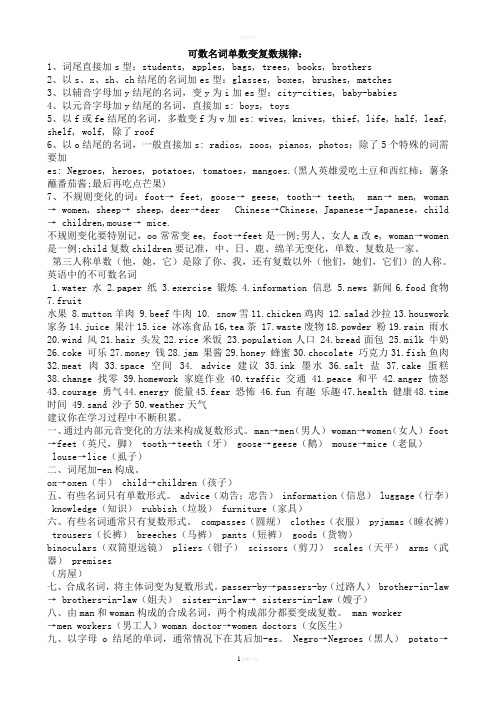
可数名词单数变复数规律:1、词尾直接加s型:students, apples, bags, trees, books, brothers2、以s、x、sh、ch结尾的名词加es型:glasses, boxes, brushes, matches3、以辅音字母加y结尾的名词,变y为i加es型:city-cities, baby-babies4、以元音字母加y结尾的名词,直接加s: boys, toys5、以f或fe结尾的名词,多数变f为v加es: wives, knives, thief, life, half, leaf, shelf, wolf, 除了roof6、以o结尾的名词,一般直接加s: radios, zoos, pianos, photos;除了5个特殊的词需要加es: Negroes, heroes, potatoes, tomatoes,mangoes.(黑人英雄爱吃土豆和西红柿:薯条蘸番茄酱;最后再吃点芒果)7、不规则变化的词:foot→ feet, goose→ geese, tooth→ teeth, man→ men, woman → women, sheep→ sheep, deer→deer Chinese→Chinese, Japanese→Japanese,child → children,mouse→ mice.不规则变化要特别记,oo常常变ee, foot→feet是一例;男人、女人a改e, woman→women 是一例;child复数children要记准,中、日、鹿、绵羊无变化,单数、复数是一家。
第三人称单数(他,她,它)是除了你、我,还有复数以外(他们,她们,它们)的人称。
英语中的不可数名词1.water 水2.paper 纸3.exercise 锻炼rmation 信息5.news 新闻6.food食物7.fruit水果 8.mutton羊肉 9.beef牛肉 10. snow雪11.chicken鸡肉 12.salad沙拉13.houswork 家务14.juice 果汁15.ice 冰冻食品16,tea茶 17.waste废物18.powder 粉19.rain 雨水20.wind 风21.hair 头发22.rice米饭 23.population人口 24.bread面包 k 牛奶26.coke 可乐27.money 钱28.jam 果酱29.honey 蜂蜜30.chocolate 巧克力31.fish鱼肉32.meat 肉33.space 空间34. advice 建议35.ink 墨水36.salt 盐37.cake 蛋糕38.change 找零39.homework 家庭作业40.traffic 交通41.peace 和平42.anger 愤怒43.courage 勇气44.energy 能量45.fear 恐怖 46.fun 有趣乐趣47.health 健康48.time 时间 49.sand 沙子50.weather天气建议你在学习过程中不断积累。
可数名词单数变复数的原则

可数名词单数变复数的原则名词单数变复数口诀(一) 规则变化名词单数变复数,直接加 -s 占多数;s, x, z, ch, sh 来结尾,直接加上 -es;词尾是 f 或 fe,加 -s 之前先变 ve;辅母 + y 在词尾,把 y 变 i 再加 -es;Y 前若是元音字,y 不变直接加s;词尾字母若是 o,常用三个已足够,要加 -es 请记好,hero, tomato, potato。
少数名词较特殊,单复数都一致;(二) 不规则变化男人女人 a 变 e,鹅足牙齿 oo 变 ee;老鼠虱婆也好记, ous 变 ic;孩子加上 ren,鱼鹿绵羊不用变。
man-men 男子woman-women 女人foot-feet 脚goose-geese 鹅tooth-teeth 牙齿mouse-mice 老鼠child-children 小孩louce-lice(虱子)sheep-sheep 绵羊 fish → fish鱼deer-deer 鹿Chinese-Chinese 中国人Japanese-Japanese 日本人【解说】:1.英语名词有单数和复数的区别,单数表示“一个”,复数表示“多于一个。
”名词由单数变复数,多数是规则的变,直接加–s。
s在元音或浊辅音后读[z],在清辅音后面读成[s],在[t]后与[t]在一起读成[ts],在[d]后与[d]一起读成[dz]。
cups杯子friend→friends朋友cat→cats猫style→styles风格 days日子hands手hats帽子2、以s,z,sh,ch,x结尾的词在词尾加-es,读[iz]classes班级 buses 公共汽车buzz-buzzes蜜蜂嗡嗡声boxes 盒子 watches手表quiz→q uizzes 测验3、以“元音字母+y”结尾的词,加-s,读作[z];以辅音字母+y 结尾的词,变y为i,再加-es,读[iz]。
army-armies 军队story-stories故family-families家factory-factories工厂 baby-babies宝贝以“元音字母+y”结尾时,-y 不变,直接加 -s。
英语可数名词由单数变复数的基本方法
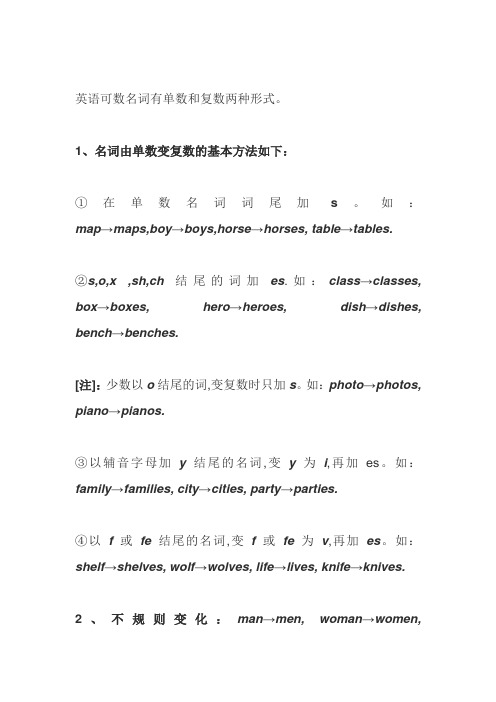
英语可数名词有单数和复数两种形式。
1、名词由单数变复数的基本方法如下:
①在单数名词词尾加s。
如:map→maps,boy→boys,horse→horses, table→tables.
②s,o,x ,sh,ch结尾的词加es.如:class→classes, box→boxes, hero→heroes, dish→dishes, bench→benches.
[注]:少数以o结尾的词,变复数时只加s。
如:photo→photos, piano→pianos.
③以辅音字母加y结尾的名词,变y为i,再加es。
如:family→families, city→cities, party→parties.
④以f或fe结尾的名词,变f或fe为v,再加es。
如:shelf→shelves, wolf→wolves, life→lives, knife→knives.
2、不规则变化:man→men, woman→women,
sheep→sheep,tooth→teeth, fish→fish, child→children, ox→oxen, goose→geese
不可数名词一般没有复数形式,说明其数量时,要用有关计量名词。
如:a bag of rice→two bags of rice, a piece of paper→three pieces of paper, a bottle of milk→five bottles of milk.。
英语可数名词单数变复数口诀

少数名词不规则,男、女、脚、牙、鹅、孩子,还有老鼠和便士 (指男—man--men 女—woman--women 脚—foot--feet 牙—tooth--teeth 鹅—goose--geese 孩子—child--children 老鼠—mouse--mice 便士—penny—pence 规律:a—e , oo---ee , child 后缀 ren)。
可数名词单数变复数口诀
(王宏军新思维英语编辑)
单数变为复数式,后加 S 统言之。
结尾 s、x、sh、ch 还有辅音加o时,统统加上 es。(如 classwatches, hero--heroes 等)。
辅音+y 结尾时,变 y 为 ies。 如:fly—flies
中、日、绵羊、鹿、人、鱼,单复相同别忘记。 (中---Chiese, 日---Japanese 绵羊---Sheep 鹿---deer 人---people 鱼---fish)
中日不变英法变,其它 S 加后边。 (Chinese—Chinese, Japanese—Japanese, Englishman—Englishmen, Franchman---Franchmen 其余国家的人直接加 S 即可)
f,fe 结尾时,去掉换成 ves。 如:wife—wives myself—ourselves
辅音+o 三特例(piano/ photo/ kilo),只加 s 记仔细。(piano---pianos, photo—photos, kilo—kilos)
要是元音加 o 时,只加 s 就可以。如:plays,radios (如 baby—babies, leae---leaves, wife—wives 等)。
最后单复意不同,意思变化要记清。 (如 work 工作 works 工厂、作品, game 游戏 民族 time 时间 times 次数/时代/时期,等。 )。
可数名词单数变复数的规则
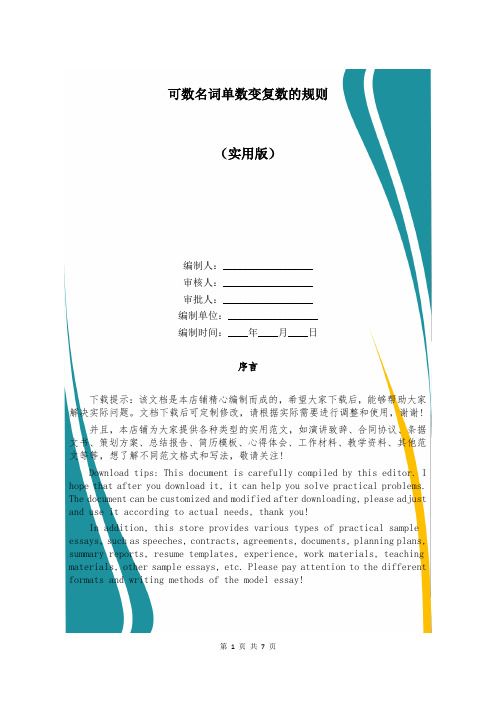
可数名词单数变复数的规则(实用版)编制人:__________________审核人:__________________审批人:__________________编制单位:__________________编制时间:____年____月____日序言下载提示:该文档是本店铺精心编制而成的,希望大家下载后,能够帮助大家解决实际问题。
文档下载后可定制修改,请根据实际需要进行调整和使用,谢谢!并且,本店铺为大家提供各种类型的实用范文,如演讲致辞、合同协议、条据文书、策划方案、总结报告、简历模板、心得体会、工作材料、教学资料、其他范文等等,想了解不同范文格式和写法,敬请关注!Download tips: This document is carefully compiled by this editor. I hope that after you download it, it can help you solve practical problems. The document can be customized and modified after downloading, please adjust and use it according to actual needs, thank you!In addition, this store provides various types of practical sample essays, such as speeches, contracts, agreements, documents, planning plans, summary reports, resume templates, experience, work materials, teaching materials, other sample essays, etc. Please pay attention to the different formats and writing methods of the model essay!可数名词单数变复数的规则可数名词单数变复数的规则(最新)一般来看,有关可数名词单数变复数的规则:直接在名词末尾加s。
小学英语可数名词单数变复数规律总结
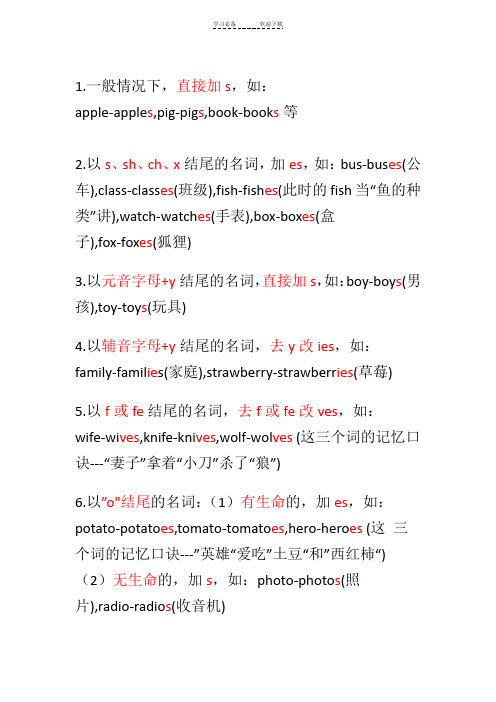
1.一般情况下,直接加s,如:apple-apple s,pig-pig s,book-book s等2.以s、sh、ch、x结尾的名词,加es,如:bus-bus es(公车),class-class es(班级),fish-fish es(此时的fish当“鱼的种类”讲),watch-watch es(手表),box-box es(盒子),fox-fox es(狐狸)3.以元音字母+y结尾的名词,直接加s,如:boy-boy s(男孩),toy-toy s(玩具)4.以辅音字母+y结尾的名词,去y改ies,如:family-famil ie s(家庭),strawberry-strawberr ies(草莓)5.以f或fe结尾的名词,去f或fe改ves,如:wife-wi ves,knife-kni ves,wolf-wol ves (这三个词的记忆口诀---“妻子”拿着“小刀”杀了“狼”)6.以”o"结尾的名词:(1)有生命的,加es,如:potato-potato es,tomato-tomato es,hero-hero es (这三个词的记忆口诀---”英雄“爱吃”土豆“和”西红柿“)(2)无生命的,加s,如:photo-photo s(照片),radio-radio s(收音机)7.将“oo”改为“ee"的名词,如:tooth-t ee th(牙),foot-f ee t(脚),goose-g ee se(鹅)8.单复同形的名词:(1)fish-fish(此时fish当“同类鱼的很多条”讲),sheep-sheep(绵羊),paper-paper(纸),Chinese-Chinese(中国人),Japanese-Japanese(日本人),people-people(peoples 表示“民族”)(2)不可数名词,如:water(水),rice(米饭),milk(牛奶),juice(果汁),bread(面包),tea(茶),orange(橙汁)9.不规则变化的名词:(1)man-men,woman-women (记忆方法---“男人”“女人”将a改e)延伸:policeman-policemen,policewoman-policemen(2)child-child ren(孩子)(3)mouse-mice(老鼠)(4)根据中文意思变化的名词,如:I-we(我-我们),you-you(你-你们),he/she/it-they(他/她/它-他们),this-these(这个-这些),that-those(那个-那些)同学们,快来看看自己做的怎么样吧!小学英语可数名词单数变复数规律总结写出下列名词的复数形式:I this that watch childphoto diary(日记)day(天)foot book dress(连衣裙)tooth sheep box strawbe rrywolf peach yo-yo(悠悠球)sandwich man womanpaper water juice tea mouseThere are 56(people)in China.答案:we these those watch es child ren photo s diar ies day s f ee tbook s dress es t ee th sheep box es strawberr ies wol ves peach es yo-yo s(悠悠球是“无生命”的,另外含有-符号的词是一个词,因此在结尾加s)sandwich esm e n wom e n paper water juice tea micepeople s(这句话的意思是---“中国有56个民族”)。
可数名词单复数变化规则口诀

可数名词单复数变化规则口诀以下是为您生成的十个关于可数名词单复数变化规则的口诀:1. 一尾加 s 很平常,名词单数变复数。
比如 book 变 books,书桌desk 变 desks。
苹果 apple 加 s,香蕉 banana 也一样。
一个变多个就这样,简单又好记不用慌。
2. 二尾若为 ch、sh、x、s,后面加上 es 别遗忘。
比如 box 变 boxes,刷子 brush 变 brushes。
公共汽车 bus 变 buses,手表 watch 变 watches。
记住规则心不慌。
3. 一辅加 y 要留意,y 变 i 再加 es 记心底。
比如 baby 变 babies,糖果 candy 变 candies。
城市 city 变 cities,工厂 factory 变 factories。
轻松变化没问题。
4. 二辅加 y 很特别,直接加 s 不用变。
比如 boy 变 boys,玩具 toy变 toys。
一天一天多积累,复数变化都学会。
5. 一尾 f 或 fe,变成 ves 要认得。
比如 knife 变 knives,妻子 wife变 wives。
树叶 leaf 变 leaves,一半 half 变 halves。
仔细区分不会错。
6. 二尾 o 来真有趣,有生命加 es 没生命加 s。
比如 hero 变 heroes,土豆 potato 变 potatoes。
无生命就像 photo 加 s,钢琴 piano 也一样。
记住区分不迷茫。
7. 一尾 man 变 men,woman 同理要记真。
比如 man 变 men,女人woman 变 women。
英国男人 Englishman 变 Englishmen,复数变化要区分。
8. 二尾 foot 变 feet,牙齿 tooth 也同例。
比如 foot 变 feet,goose 变geese 要留意。
认真学习多练习,单复变化没问题。
9. 一尾 child 变 children,不规则变化要用心。
英语可数名词变复数的规则

英语可数名词变复数的规则英语名词单数变复数主要有以下规则:一、绝大多数的可数名词的复数形式,是在该词末尾加上后辍-s。
读音变化:结尾是清辅音读[s],结尾是浊辅音或元音读[z]。
例:friend→friends; cat→cats; style→styles; sport→sports; piece→pieces二、凡是以s、z、x、ch、sh结尾的词,在该词末尾加上后辍-es构成复数。
读音变化:统一加读[iz]。
例:bus→buses; quiz→quizzes; fox→foxes; match→matches; flash→flashesbox →boxes; watch →watches; actress →actresses; class →classes;coach(长途车)→coaches; dress →dresses; sandwich →sandwiches;toothbrush →toothbrushes; waitress(女侍者)→waitresses三、以辅音字母+y结尾的名词,将y改变为i,再加-es。
读音变化:加读[z]。
例:candy→candies; daisy(雏菊)→daisies; fairy→fairies; lady→ladies;story→stories strawberry →strawberries; baby →babies;puppy →puppies; library →libraries; dictionary →dictionaries;cherry →cherries; activity →activities四、以-o结尾的名词,如果不是外来词或缩写,就加-es,否则加-s构成复数。
(有生命的加es,无生命的加s)读音变化:加读[z]。
例:tomato→tomatoes; potato→potatoes; torpedo(鱼雷)→torpedoes; bingo(彩票式游戏)→bingoes反例:silo(青贮塔)→silos; piano→pianos(外来词); photo→photos;macro(宏指令,计机算语言)→macros(缩写词)五、以-f或-fe结尾的名词,多为将-f或-fe改变为-ves,但有例外。
- 1、下载文档前请自行甄别文档内容的完整性,平台不提供额外的编辑、内容补充、找答案等附加服务。
- 2、"仅部分预览"的文档,不可在线预览部分如存在完整性等问题,可反馈申请退款(可完整预览的文档不适用该条件!)。
- 3、如文档侵犯您的权益,请联系客服反馈,我们会尽快为您处理(人工客服工作时间:9:00-18:30)。
可数名词单数变复数规律:1、词尾直接加s型:students, apples, bags, trees, books, brothers2、以s、x、sh、ch结尾的名词加es型:glasses, boxes, brushes, matches3、以辅音字母加y结尾的名词,变y为i加es型:city-cities, baby-babies4、以元音字母加y结尾的名词,直接加s: boys, toys5、以f或fe结尾的名词,多数变f为v加es: wives, knives, thief, life, half, leaf, shelf, wolf, 除了roof6、以o结尾的名词,一般直接加s: radios, zoos, pianos, photos;除了5个特殊的词需要加es: Negroes, heroes, potatoes, tomatoes,mangoes.(黑人英雄爱吃土豆和西红柿:薯条蘸番茄酱;最后再吃点芒果)7、不规则变化的词:foot→feet, goose→geese, tooth→teeth,man→men, woman→women, sheep→sheep, deer→deerChinese→Chinese, Japanese→Japanese,child→children,mouse→mice.不规则变化要特别记,oo常常变ee, foot→feet是一例;男人、女人a改e, woman→women是一例;child复数children要记准,中、日、鹿、绵羊无变化,单数、复数是一家。
第三人称单数(他,她,它)是除了你、我,还有复数以外(他们,她们,它们)的人称。
英语中的不可数名词1.water 水2.paper 纸3.exercise 锻炼rmation 信息5.news 新闻6.food食物7.fruit水果8.mutton羊肉9.beef牛肉10. snow雪11.chicken 鸡肉12.salad沙拉13.houswork 家务14.juice 果汁15.ice 冰冻食品16,tea茶17.waste废物18.powder 粉19.rain 雨水20.wind 风21.hair 头发22.rice米饭23.population人口24.bread面包k 牛奶26.coke 可乐27.money 钱28.jam 果酱29.honey 蜂蜜30.chocolate 巧克力31.fish鱼肉32.meat 肉33.space 空间34. advice 建议35.ink 墨水36.salt 盐37.cake 蛋糕38.change 找零39.homework 家庭作业40.traffic 交通41.peace 和平42.anger 愤怒43.courage 勇气44.energy 能量45.fear 恐怖46.fun 有趣乐趣47.health 健康48.time 时间49.sand 沙子50.weather天气建议你在学习过程中不断积累。
不规则名词复数的单词有哪些?一、通过内部元音变化的方法来构成复数形式。
man→men(男人)woman→women(女人)foot→feet(英尺,脚)tooth→teeth(牙)goose→geese(鹅)mouse→mice(老鼠)louse→lice(虱子)二、词尾加-en构成。
ox→oxen(牛)child→children(孩子)三、以f或fe结尾,在构成复数时,去掉f或fe加-ves。
half→halves(半)thief→thieves(贼)wife→wives(妻子)life→lives(生命)knife→knives(小刀)wolf→wolves(狼)calf→calves(小牛)shelf→shelves(架子)leaf→leaves(叶)loaf→loaves(面包的块、条)sheaf→sheaves(捆)self→selves(自己)四、单、复数相同的形式。
one sheep(一只羊)→two sheep(两只羊)a deer(一只鹿)→two deer(两只鹿)a Chinese(一个中国人)→two Chinese(两个中国人)五、有些名词只有单数形式。
advice(劝告;忠告)information(信息)luggage(行李)knowledge(知识)rubbish(垃圾)furniture(家具)六、有些名词通常只有复数形式。
compasses(圆规)clothes(衣服)pyjamas(睡衣裤)trousers(长裤)breeches(马裤)pants(短裤)goods(货物)binoculars(双筒望远镜)pliers(钳子)scissors(剪刀)scales(天平)arms(武器)premises(房屋)七、合成名词,将主体词变为复数形式。
passer-by→passers-by(过路人)brother-in-law→brothers-in-law(姐夫)sister-in-law→sisters-in-law(嫂子)八、由man和woman构成的合成名词,两个构成部分都要变成复数。
man worker→men workers(男工人)woman doctor→women doctors(女医生)九、以字母o结尾的单词,通常情况下在其后加-es。
Negro→Negroes(黑人)potato→potatoes(土豆,马铃薯)tomato→tomatoes(蕃茄,西红柿)小学英语可数名词单数变复数规律总结1.一般情况下,直接加s,如:apple-apple s,pig-pig s,book-book s等2.以s、sh、ch、x结尾的名词,加es,如:bus-bus es(公车),class-class es(班级),fish-fish es(此时的fish当“鱼的种类”讲),watch-watch es(手表),box-box es(盒子),fox-fox es(狐狸)3.以元音字母+y结尾的名词,直接加s,如:boy-boy s(男孩),toy-toy s(玩具)4.以辅音字母+y结尾的名词,去y改ies,如:family-famil ie s(家庭),strawberry-strawberr ies(草莓)5.以f或fe结尾的名词,去f或fe改ves,如:wife-wi ves,knife-kni ves,wolf-wol ves (这三个词的记忆口诀---“妻子”拿着“小刀”杀了“狼”)6.以”o"结尾的名词:(1)有生命的,加es,如:potato-potato es,tomato-tomato es,hero-hero es (这三个词的记忆口诀---”英雄“爱吃”土豆“和”西红柿“)(2)无生命的,加s,如:photo-photo s(照片),radio-radio s(收音机)7.将“oo”改为“ee"的名词,如:tooth-t ee th(牙),foot-f ee t(脚),goose-g ee se(鹅) 8.单复同形的名词:(1)fish-fish(此时fish当“同类鱼的很多条”讲),sheep-sheep(绵羊),paper-paper(纸),Chinese-Chinese(中国人),Japanese-Japanese(日本人),people-people(peoples表示“民族”)(2)不可数名词,如:water(水),rice(米饭),milk(牛奶),juice(果汁),bread(面包),tea(茶),orange(橙汁)9.不规则变化的名词:(1)man-men,woman-women (记忆方法---“男人”“女人”将a改e) 延伸:policeman-policemen,policewoman-policemen (2)child-child ren(孩子)(3)mouse-mice(老鼠)(4)根据中文意思变化的名词,如:I-we(我-我们),you-you(你-你们),he/she/it-they(他/她/它-他们),this-these(这个-这些),that-those(那个-那些)现在进行时一.意义——当表示现在正在进行的动作或正在发生的事。
二.构成:be (am, is ,are )+动词现在分词-ing形式肯定句:主语+ be + 现在分词V-ing (+ 其他)I’m doing my homework now .否定句:主语+be+not+动词-ing +其他.I’m not doing my homework now.一般疑问句:Be+主语+动词-ing +其他?Are you doing your home work now? Yes, I am . No , I’m not . 特殊疑问句:特殊疑问词+be+主语+动词-ing+其他?What are you doing now ?三. 现在分词的构成:(1)一般在动词末尾直接加ing,(2)以不发音字母e结尾的动词,先去掉e,再加ing,如skate →skating make →making dance →dancing write →writin g have →having ride →riding come →coming(3)以重读闭音节结尾的动词,中间只有一个元音字母,词尾只有一个辅音字母,应双写末尾的辅音字母,再加ing, 如:putting running beginningstopping swimming shoppingjoggingsittinggettingforgettingletting四.时间标志——now,句前的look ,listen一般现在时一. 意义:表示经常发生的事情,动作或存在的状态二. 构成及变化1.be动词的变化。
肯定句:主语+be(am,is,are)+其它。
如:I am a boy.我是一个男孩。
否定句:主语+ be + not +其它。
如:He is not a worker.他不是工人。
一般疑问句:Be +主语+其它。
如:-Are you a student? -Yes. I am. / No, I'm not.特殊疑问句:疑问词+一般疑问句。
如:Where is my bike?2. 行为动词的变化。
当主语为第一,二人称及复数时,助动词为do肯定句:主语+动词原形(+其它)。
如:We often play basketball after sc hool.否定句:主语+ don't+动词原形(+其它)。
如:we don’t play basketball after school.一般疑问句:Do +主语+动词原形+其它?如:Do you often play basketball after school l? Yes, we do. / No, we don't.特殊疑问句:疑问词+以do开头的一般疑问句?如:What do you often do after school ?当主语为第三人称单数时,助动词为does肯定句:主语+动词三单式(+其它)。
